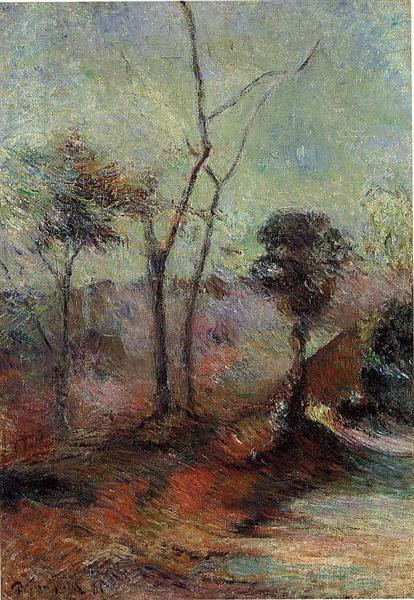Opis
Paul Gauguin's "Landscape - 1885" represents one of the initial stages of his artistic career, where he began to explore the richness of colour and form that would characterise him over time. Although it is situated in the period of post-impressionism, this painting already reveals his inclination towards a more subjective vision of the world, distant from the realistic representation that dominated his earlier painting.
Looking at the work, the first thing that strikes you is the bold use of color. Gauguin applies a palette that evokes a vibrant contrast between the herbal greens of the foreground and the deep blues of the background. The vegetation is represented in an almost symbolic manner, with forms that seem to emerge from the imagination rather than from direct observation of nature. The trees in the foreground are not simple specters of the real world; their forms are simplified and stylized, suggesting a connection with the influences of Japanese art, which so impacted the Impressionists and Gauguin in particular. This approach also foreshadows his future experimentation with what he considered a "painting of the spirit."
On the left, this landscape features gently arching hills, visually appealing and seeming to embrace the background of the painting. Here shades of yellow and green are intertwined as well as blue, generating great dynamism. The compositional structure shows a balance that feels both natural and intentional, where the elements of the landscape are grouped in a way that guides the viewer's gaze without forcing it, encouraging a contemplative experience.
Although Landscape - 1885 does not feature human figures, their absence accentuates the deep connection between the viewer and nature. Often, the landscape in Gauguin's work becomes a character in itself, an enveloping sensory experience that suggests the possibility of introspection and isolation. This idea of nature as a reflection of the soul would be a recurring theme throughout his work and life.
Additionally, this painting is set in a time when Gauguin was beginning to distance himself from the conventions of Impressionism and to rethink his relationship with art, seeking to find not only the external beauty of the world, but also a representation of what he experienced internally. His search for emotional authenticity through color and form was one of the characteristics that would soon lead him to the symbolic influence and his famous exploration in Tahiti. Thus, although "Landscape - 1885" is not one of his most recognizable works, it lays the foundation for understanding his evolution as an artist, inviting us to discover the vast connection between the external landscape and the internal world of the human being.
In conclusion, “Landscape – 1885” is not simply a painting; it is an affirmation of Gauguin’s transition to an art full of color, energy and emotion, solitary in its essence, but deeply resonant in its ability to evoke sensations and reflections on nature and existence. This work invites us to contemplate beyond the surface, suggesting that every landscape carries with it not only its vastness and beauty, but also a kaleidoscope of human emotions.
KUADROS ©, a famous painting on your wall.
Hand-made oil painting reproductions, with the quality of professional artists and the distinctive seal of KUADROS ©.
Painting reproduction service with satisfaction guarantee. If you are not completely satisfied with the replica of your painting, we will refund 100% of your money.

